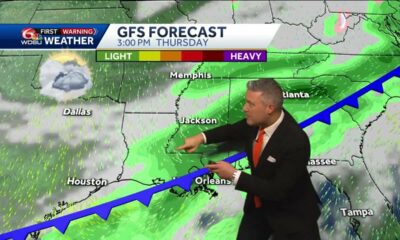News from the South - North Carolina News Feed
With stubborn turbidity and concerns about water clarity growing, city amps up testing on the non-potable water it’s delivering
With turbidity at North Fork Reservoir barely budging in recent days, the City of Asheville continues to deliver discolored, non-potable water to customers, and announced Wednesday it has amped up its testing program.
Several water customers have reached out to Asheville Watchdog to express concerns about the water quality and whether it is safe for showering. A Water Resources spokesperson assured residents that the water is safe for non-consumption uses.
The entire city water system remains under a boil water notice, and the city has stressed that the heavily chlorinated but unfiltered water it’s distributing from North Fork Reservoir is meant only for flushing commodes, taking showers and other non-potable uses. Customers should use bottled water for drinking water.
Water Resources Department spokesperson Clay Chandler spent most of his time at the daily Helene briefing on Wednesday talking about the water testing program, but he said afterward it does not come in response to customer complaints.
“We certainly don’t underestimate customer concerns, but the testing plan on the website was formulated by us and approved by our regulators before we started moving water from North Fork,” Chandler said. “It’s definitely fair to say that we’ve leaned into making it accessible as possible in response to questions and concerns from customers.”
Chandler said the department conducts daily testing throughout the distribution system for total coliform, E. coli and chlorine “to ensure the safety of our customers.” Coliform is a bacteria commonly found in the environment and the intestines of humans and mammals, E. coli is a bacteria that can cause serious intestinal infections, and chlorine is a chemical used as a disinfectant in municipal water systems. There has been no evidence of E. coli, Chandler said, and chlorine levels remain high.
The water department, with guidance from the EPA and the North Carolina Department of Environmental Quality, “developed and implemented a sampling plan specific to recovering from Helene,” he said.
In all, Water Resources has 184 sampling stations throughout the system, and under normal conditions it runs tests on eight to 10 per day. While some chemicals have tested higher than recommended amounts, the levels are not significant, Chandler said.
“Since Helene, we have tested an average of 35 stations per day, and we hope to get that up to 40,” Chandler said, adding that testing is “slightly more accurate when the water is clear. And again, the water at North Fork, as everybody knows by now, is extremely turbid.”
Turbidity is measured in Nephelometric Turbidity Units, or NTUs, and the EPA requires filter water to be less than .30 NTU for consumption. At North Fork, normal filtered water is between .03 and .05 NTU, but since the storm it’s remained stubbornly high, including Wednesday when it measured 26, according to Chandler.
It was nearly the same level Monday, and it stood at 30 on Oct. 11.
Clarity of the reservoir, which was stirred up and then inundated by clay-laden floodwaters on Sept. 27, is key to once again providing the system’s 63,000 users with potable water.
“The target that we have now is 1.5 NTUs, which, while it’s a little bit higher than what we normally see, is still much lower than if you were to average water systems across the United States,” Chandler said.
North Fork serves about 80 percent of the city’s water customers, and the city has already conducted one mineral treatment program designed to help with turbidity — an infusion of aluminum sulfate and caustic soda — but it has not been very effective, in part because of high winds the two days the chemicals were administered.
“Since we’re under some pretty extraordinary circumstances, we have decided to go ahead and test daily for aluminum, iron and manganese, because we know those can be elements of concern,” Chandler said.
While these minerals do cause discoloration and cloudiness in the water, they are generally safe in low levels.
“It’s certainly accurate to say that low levels of aluminum, iron and manganese are naturally occurring in water supplies and do not pose significant health hazards at those levels,” Chandler said after the briefing.
Typically, elevated levels of these substances are “extremely rare under normal circumstances,” he said.
North Fork’s filters are made for clear water, as that’s what the reservoir’s heavily forested 20,000-acre watershed generally provides. The city will conduct another mineral treatment next week, and it plans to install a three-layer “curtain” system next week that should help improve water clarity.
Earlier in the week, Chandler said portable filtration systems exist, but North Fork pumps out more than 20 million gallons of water daily, a level of production those units can’t handle.
“That does not mean that we have given up on that,” Chandler said. “The Army Corps of Engineers is putting pencil back to paper to see if they can come up with some solutions that can meet the 20 million gallons per day capacity that we have to meet.”
“If I sort of implied that that part of it had been given up on, that is absolutely not the case,” Chandler continued. “Water Resources, our partners at EPA, and the Army Corps of Engineers are working literally around the clock to come up with something.”
Chlorine levels are high
The federal government has set secondary “Maximum Contaminant Limits,” or MCLs for drinking water. Normally, the city water has a chlorine level of four parts per million.
“But after Helene, both the EPA and North Carolina DEQ allowed us to chlorinate initially at eight parts per million, because that was the only thing that we could add to the water,” Chandler said. “Remember, we’re not using our normal treatment and filtration systems. We’re sending water straight out of the lake and hyper-chlorinating it.”
The city has since dropped that level to six parts per million.
“It’s a very good sign, because that means as we test for chlorine throughout the distribution system, chlorine levels are remaining high, because there are very few pathogens in the distribution system that’s eating it up,” Chandler said. “So if chlorine remains high throughout the distribution system, that’s a very positive sign.”
Since Helene, the city has had no detections of E. coli.
“We are not allowed a single positive (test result) here for E. coli, because that would automatically trigger a boil water (notice),” Chandler said. “And to be clear, that is not the reason we issued the boil water notice that we’re under now. We issued that boil water notice because of the sediment that’s in the water.”
Customers have likely noticed the water in their homes or businesses being cloudy and brown in some places, Chandler said. “That is why we are under this current boil water notice, not an E. coli positive hit.”
Discoloration mostly an aesthetic issue
The discolored water is mostly an aesthetic issue, although the water is not drinkable. Chandler acknowledged that, “Obviously, clear water is more appealing. Cloudy water is not.”
But he noted that federal and state regulators do not enforce recommendations on water aesthetics.
“For example, the levels of iron and manganese in the unfiltered water that we’ve sent through our distribution system have slightly exceeded the MCLs, and our regulators are completely aware of that,” Chandler said. “They’re at North Fork every day. They’re in City Hall, in our offices, every day.”
The practical effect of the discolored water is that “those with medical conditions who might be susceptible to increased levels of aluminum or manganese, should simply consult with their doctor,” Chandler said.

Aluminum produces a cloudy look to the water, Chandler said, while the rusty look comes from iron, which also leaves a metallic taste and causes a reddish-brown staining on toilets.
Manganese, which is black to brown in color, “causes a metallic taste in the water and produces yellow staining on toilets and other appliances,” Chandler said.
“It is also very important to note that the in-reservoir treatment process that we concluded last week and that we will restart next week, it will actually work to reduce levels of iron and manganese in the water,” he said.
Aluminum sulfate is a “salt-ish” mineral the department uses to regularly treat the reservoir, as it makes clay particles coagulate and sink, leading to clearer water for filtering and treatment. Caustic soda helps with optimum pH levels for the coagulation to work best.
Chandler said it’s important to note the city has “not exceeded the MCL as far as aluminum yet.
“We know that level is going to go up next week when we start the second round of the in-reservoir treatment process, and so that’s why we’re rolling out these real time test results today,” he said.
Chandler also noted that with school restarting next week, the city has tested water for lead at every city school, with the exception of Hall Fletcher Elementary, which is in the process of switching from city water to a newly installed well. That testing will take seven to 10 business days.
The city has a lengthy FAQ section on its water recovery page, and it contains information about the testing program.
Asheville Watchdog is a nonprofit news team producing stories that matter to Asheville and Buncombe County. John Boyle has been covering Asheville and surrounding communities since the 20th century. You can reach him at (828) 337-0941, or via email at jboyle@avlwatchdog.org. To show your support for this vital public service go to avlwatchdog.org/support-our-publication/.
Related
The post With stubborn turbidity and concerns about water clarity growing, city amps up testing on the non-potable water it’s delivering appeared first on avlwatchdog.org
News from the South - North Carolina News Feed
Severe weather nationwide impacts holiday travel
SUMMARY: Northern California has experienced over 17 inches of rain since Tuesday, causing severe flooding in Sonoma County, including submerged vineyards and a man’s car being swept away. In Santa Rosa, fallen trees and power lines have raised concerns. Meanwhile, the Northeast is cleaning up from its first snowfall, with heavy snow causing road blockages and power outages, especially in Pennsylvania. The Sierra Nevada has received over 20 inches of snow, with more expected. Severe weather is moving eastward, causing potential travel delays across the U.S., including in Denver and New York City for Thanksgiving Day.
The holidays are here. Here’s how the weather may be impacting those traveling.
More: https://abc11.com/tag/holiday-travel/
Watch: https://abc11.com/watch/live/11065013/
Like us on Facebook: https://www.facebook.com/ABC11/
X: https://twitter.com/ABC11_WTVD
TikTok: https://www.tiktok.com/@abc11_eyewitnessnews
News from the South - North Carolina News Feed
Two women killed and several children hurt in Johnston County crash
SUMMARY: Two women in their 20s died in a car crash in Johnson County, with six children aged under 12 also in the vehicle; one child is in critical condition. The single-car accident occurred at the intersection of Government and Jack roads in Clayton. Investigators report that the driver, speeding about 30 mph over the limit and running a stop sign, lost control, hitting a ditch and a tree before the Jeep Cherokee went airborne. None of the occupants were wearing seat belts, and while alcohol isn’t suspected, the area has a history of crashes.
Two women were killed and several children were hospitalized after an SUV crashed Saturday night in Johnston County.
News from the South - North Carolina News Feed
1.3 million people in NC act as caregivers for family members
SUMMARY: This month, National Caregivers Month honors those supporting individuals with special needs. Haley King, born with an extra chromosome, defied early grim predictions, thanks to the unwavering support of her parents and the Tammy Lynn Center in Raleigh. The center offers vital programs like residential care, therapeutic support, and day services but has a waiting list of 18,000 people. Experts emphasize the importance of caregivers finding additional resources, including family support groups. Tammy Lynn Center CEO Sarah Crawford urges the public to educate themselves about the needs of individuals with disabilities, while Haley, now 33, continues to thrive and spread joy.
During Caregivers Awareness, Julian Grace shares how their work helps the lives of several NC families, and that some caregivers say the job is taking a toll on their mental health.
Subscribe to WRAL:
https://youtube.com/c/wral5
Download the WRAL App: https://www.wral.com/download-wral-apps/5787234/
News Tips:
Online – https://www.wral.com/report-it/
Email – assignmentdesk@wral.com
Follow WRAL:
Facebook: https://facebook.com/WRALTV
X: https://twitter.com/WRAL
IG: https://instagram.com/wral
About WRAL-TV:
WRAL is your Raleigh, North Carolina news source. Check out our videos for the latest news in Raleigh, local sports, Raleigh weather, and more at https://WRAL.com
#localnews #northcarolina
-

 Kaiser Health News7 days ago
Kaiser Health News7 days agoA Closely Watched Trial Over Idaho’s Near-Total Abortion Ban Continues Tuesday
-

 Local News3 days ago
Local News3 days agoIntroducing our Student Athlete of the Week: Ocean Springs’ very own Mackenzie Smith
-

 Local News6 days ago
Local News6 days agoSherral’s Diner to be featured on America’s Best Restaurants
-

 News from the South - Georgia News Feed5 days ago
News from the South - Georgia News Feed5 days agoJose Ibarra found guilty in murder of Laken Riley | FOX 5 News
-

 News from the South - Alabama News Feed5 days ago
News from the South - Alabama News Feed5 days agoTrial underway for Sheila Agee, the mother accused in deadly Home Depot shooting
-

 News from the South - Kentucky News Feed4 days ago
News from the South - Kentucky News Feed4 days agoNicholasville organization activates weather plan in response to bitter cold temperatures
-

 News from the South - Alabama News Feed4 days ago
News from the South - Alabama News Feed4 days agoJudge grants mistrial in Sheila Agee trial due to ‘unhinged juror’
-

 News from the South - Alabama News Feed5 days ago
News from the South - Alabama News Feed5 days agoAlabama's weather forecast is getting colder, and a widespread frost and freeze is likely by the …























